
Browse an alphabetical list of photographs. These historical images portray people, places, and events before, during, and after World War II and the Holocaust.
<< Previous | Displaying results 1826-1850 of 2641 for "Photo" | Next >>
Reinhard Heydrich, chief of the SD (Security Service) and Nazi governor of Bohemia and Moravia. Place uncertain, 1942.
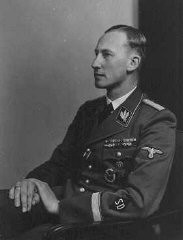
Portrait of Sara Ischach, wife of Lazar Ischach. She lived at Drinksa 77 in Bitola. This photograph was one of the individual and family portraits of members of the Jewish community of Bitola, Macedonia, used by Bulgarian occupation authorities to register the Jewish population prior to its deportation in March 1943.
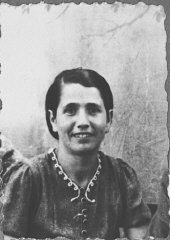
Portrait of Sara Israel, wife of Isak Israel. She lived at Krstitsa 10 in Bitola. This photograph was one of the individual and family portraits of members of the Jewish community of Bitola, Macedonia, used by Bulgarian occupation authorities to register the Jewish population prior to its deportation in March 1943.
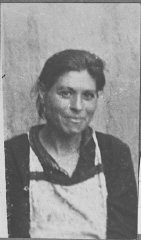
Portrait of Sigmund Freud. Freud's writings were burned during the 1933 book burnings.
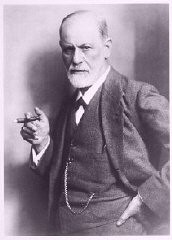
Portrait of Solomon Kalderon, son of Bohor Kalderon. He was a tailor and lived at Karagoryeva 67 in Bitola. This photograph was one of the individual and family portraits of members of the Jewish community of Bitola, Macedonia, used by Bulgarian occupation authorities to register the Jewish population prior to its deportation in March 1943.
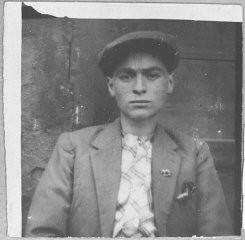
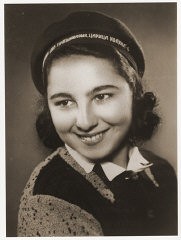
Portrait of the family of Bohor Kalderon. This photograph was one of the individual and family portraits of members of the Jewish community of Bitola, Macedonia, used by Bulgarian occupation authorities to register the Jewish population prior to its deportation in March 1943.
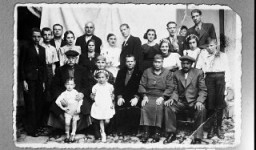
Group portrait of members of the Katz family of Munkacs. Pictured in the top row from left to right are: Chicha, Isabella, Philip, Jolon (Cipi), and Regina. In the bottom row are Helen (left) and Tereza. Munkacs, 1942–1943.
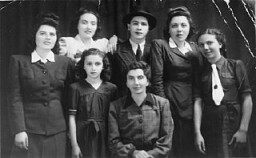
This portrait from around 1922 depicts three generations of the Menaker family. The hairstyles and clothing highlight the process of acculturation–adapting to and even adopting elements of the dominant, non-Jewish culture–in one Jewish family in the Lwów region. The older female relative wears a wig and a dress with long sleeves and a high collar. Orthodox Jewish women traditionally wore modest clothing and covered their hair with wigs or kerchiefs. By contrast, Szprinca (center) wears a dress with…
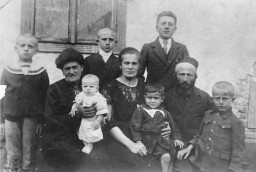
Portrait of the Rosenblat family in interwar Poland. Photographed are: (back row from left to right) Elya, Jozef (father), and Itzik Rosenblat. Sitting from left to right are: Herschel, Deena (wife of Elya), Hannah (mother), and Taube Rosenblat (wife of Itzik). In 1941, a mobile killing unit killed Herschel in Slonim, Poland. Of the others, only Itzik and Deena survived deportation from the ghetto in Radom, Poland.
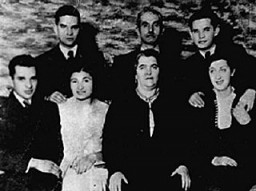
This 1935 portrait shows Samuel and Adela Shiber with three of their children—Salomon (left), Matylda (center), and Emanuel (right). The Shibers were a Jewish family from Lwów. Samuel owned a textile workshop in the city. Samuel and Adela spoke Yiddish at home, while the children spoke Polish among themselves. In this photo, there are no obvious markers of Jewish identity. The family wears clothing typical for middle or upper class families at the time. The children are dressed like most schoolchildren…
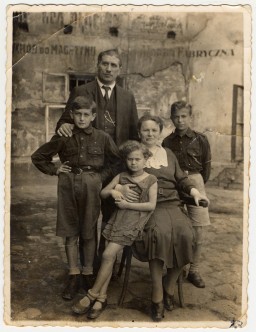
Portrait of the Weidenfeld family wearing Jewish badges in the Czernowitz (Cernauti) ghetto shortly before their deportation to Transnistria. Pictured from left to right are Yetty, Meshulem-Ber, Sallie, and Simche Weidenfeld. Cernauti, Romania, October 1941.
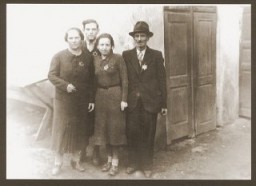
Portrait of three-year-old Estera Horn wrapped in a fur coat. Chelm, Poland, ca. 1940. Estera was born in January 1937. Her father was killed soon after the Germans invaded Poland. Estera and her mother, Perla Horn, were forced into the ghetto in Chelm. At the end of 1942, during the liquidation of the ghetto, Perla and Estera escaped from the ghetto. They hid in nearby villages. In late 1943, Perla asked a family in Plawnice to take care of Estera. Perla tried to hide with a group of Jews in the nearby…
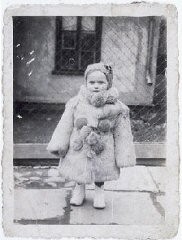
Portrait of Tosia Altman (1918-1943), Jewish youth leader and member of the Jewish underground in the Warsaw ghetto.
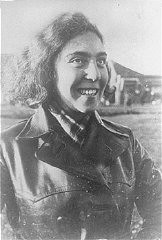
Portrait of Tsewie Herschel seated in a chair, taken while he was living in hiding. Oosterbeek, the Netherlands, 1943–1944. Tsewie never knew his parents. Born in December 1942, he was hidden with the de Jong family in April 1943. That July, his parents were deported from the Netherlands to the Sobibór killing center. The de Jongs renamed Tsewie "Henkie," raised him as a Christian, and treated him as their son. Tsewie learned about his origins from his paternal grandmother, who reclaimed him…

Portrait of two Romani (Gypsy) women. Both were deported to Auschwitz in 1941. Photograph taken in Czechoslovakia, 1937.
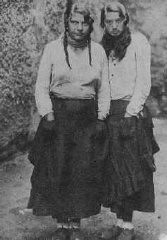
Portrait of two schoolchildren: Solomon Faradji, son of Avram Faradji, and Sami Levi, son of Rafael Levi. Solomon lived at Karagoryeva 113, and Sami lived at Karagoryeva 105, in Bitola. This photograph was one of the individual and family portraits of members of the Jewish community of Bitola, Macedonia, used by Bulgarian occupation authorities to register the Jewish population prior to its deportation in March 1943.
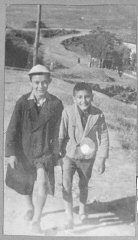
Portrait of Victoria and Isak Assael, the daughter and son of Shabetai Assael. They were students and lived at Sremska 9 in Bitola. This photograph was one of the individual and family portraits of members of the Jewish community of Bitola, Macedonia, used by Bulgarian occupation authorities to register the Jewish population prior to its deportation in March 1943.
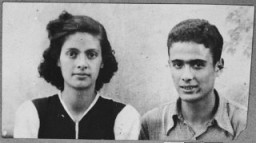
Portrait of Vida Kalderon, wife of Yakov Kalderon. She lived at Orisarska 2 in Bitola. This photograph was one of the individual and family portraits of members of the Jewish community of Bitola, Macedonia, used by Bulgarian occupation authorities to register the Jewish population prior to its deportation in March 1943.
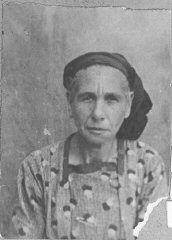
Walter Marx (standing at left) with father Ludwig, mother Johanna, and cousin Werner. In 1944, Walter joined partisans in Italy. He was the only one in the photograph to survive the Holocaust.
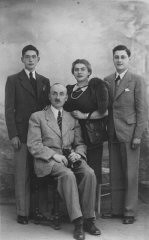
Portrait of writer Sigrid Undset, who won the Nobel Prize for Literature in 1928. Often with feminist themes, her novels were banned and burned in part because of her public criticism of the Nazi regime. Photo taken by Anders Beer Wilse on July 1, 1923.
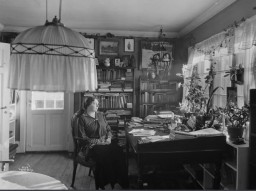
Portrait of Yakov Testa with wife and three children in Bitola. This photograph was one of the individual and family portraits of members of the Jewish community of Bitola, Macedonia, used by Bulgarian occupation authorities to register the Jewish population prior to its deportation in March 1943.
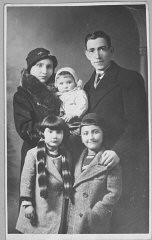
Portrait of Yosef Eschkenasi and his wife, Sara. Yosef was a laborer. They lived at Zmayeva 10 in Bitola. This photograph was one of the individual and family portraits of members of the Jewish community of Bitola, Macedonia, used by Bulgarian occupation authorities to register the Jewish population prior to its deportation in March 1943.
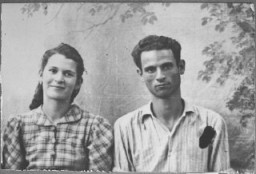
Portrait of Władysław Bartoszewski, Poland, unknown date. Władysław Bartoszewski (1922–2015) was a co-founder and member of the Council for Aid to Jews, codenamed “Żegota.” Żegota was a clandestine rescue organization of Poles and Jews in German-occupied Poland. Supported by the Polish government-in-exile, Żegota coordinated efforts to save Jews from Nazi persecution and murder. It operated from 1942 to 1945. After World War II broke out in September 1939, Władysław worked as a janitor…
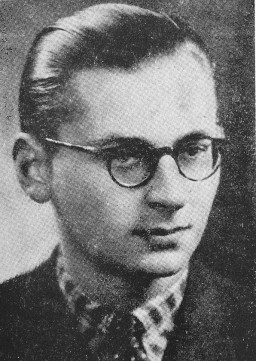
Wartime portrait of Andrzej Klimowicz, Poland. Andrzej Klimowicz (1918–1996) aided and rescued Jews in Warsaw throughout the duration of the German occupation of Poland. He eventually became a member of the Council for Aid to Jews (codenamed “Żegota”), a clandestine organization that coordinated efforts to save Jews from Nazi persecution and murder. Under the auspices of Żegota, Andrzej played a role in providing Jews in Warsaw with forged identity papers and hiding places outside the walls of the…
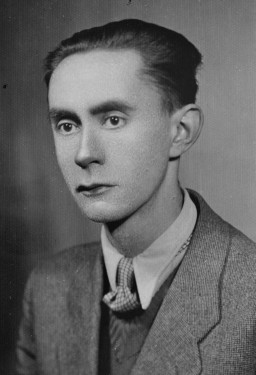
We would like to thank Crown Family Philanthropies, Abe and Ida Cooper Foundation, the Claims Conference, EVZ, and BMF for supporting the ongoing work to create content and resources for the Holocaust Encyclopedia. View the list of donor acknowledgement.